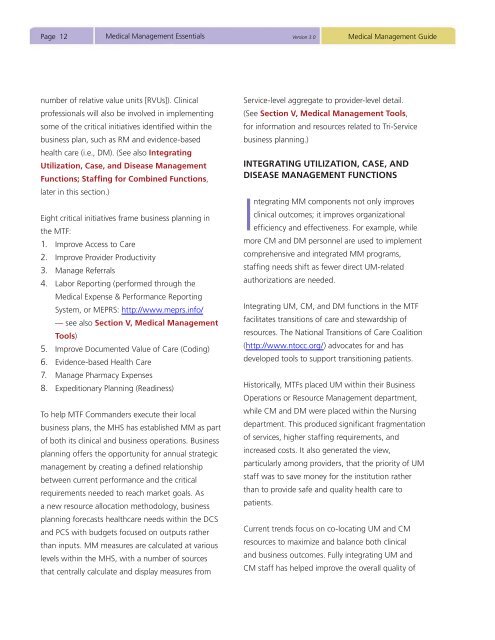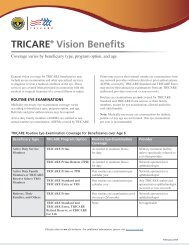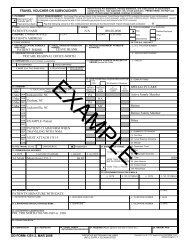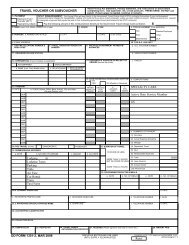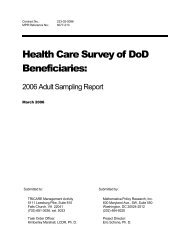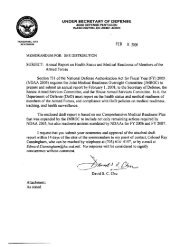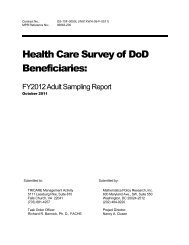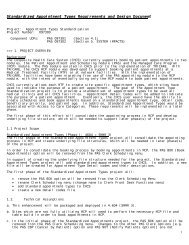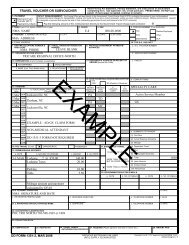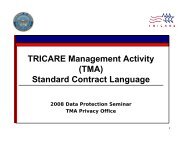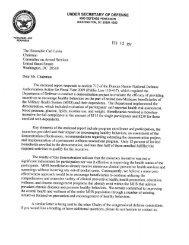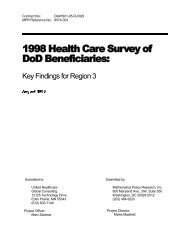Medical Management Guide, 2009, Version 3.0 - Tricare
Medical Management Guide, 2009, Version 3.0 - Tricare
Medical Management Guide, 2009, Version 3.0 - Tricare
- No tags were found...
Create successful ePaper yourself
Turn your PDF publications into a flip-book with our unique Google optimized e-Paper software.
Page 12 <strong>Medical</strong> <strong>Management</strong> Essentials<strong>Version</strong> <strong>3.0</strong><strong>Medical</strong> <strong>Management</strong> <strong>Guide</strong>number of relative value units [RVUs]). Clinicalprofessionals will also be involved in implementingsome of the critical initiatives identified within thebusiness plan, such as RM and evidence-basedhealth care (i.e., DM). (See also IntegratingUtilization, Case, and Disease <strong>Management</strong>Functions; Staffing for Combined Functions,later in this section.)Eight critical initiatives frame business planning inthe MTF:1. Improve Access to Care2. Improve Provider Productivity3. Manage Referrals4. Labor Reporting (performed through the<strong>Medical</strong> Expense & Performance ReportingSystem, or MEPRS: http://www.meprs.info/— see also Section V, <strong>Medical</strong> <strong>Management</strong>Tools)5. Improve Documented Value of Care (Coding)6. Evidence-based Health Care7. Manage Pharmacy Expenses8. Expeditionary Planning (Readiness)To help MTF Commanders execute their localbusiness plans, the MHS has established MM as partof both its clinical and business operations. Businessplanning offers the opportunity for annual strategicmanagement by creating a defined relationshipbetween current performance and the criticalrequirements needed to reach market goals. Asa new resource allocation methodology, businessplanning forecasts healthcare needs within the DCSand PCS with budgets focused on outputs ratherthan inputs. MM measures are calculated at variouslevels within the MHS, with a number of sourcesthat centrally calculate and display measures fromService-level aggregate to provider-level detail.(See Section V, <strong>Medical</strong> <strong>Management</strong> Tools,for information and resources related to Tri-Servicebusiness planning.)INTEGRATING UTILIZATION, CASE, ANDDISEASE MANAGEMENT FUNCTIONSIntegrating MM components not only improvesclinical outcomes; it improves organizationalefficiency and effectiveness. For example, whilemore CM and DM personnel are used to implementcomprehensive and integrated MM programs,staffing needs shift as fewer direct UM-relatedauthorizations are needed.Integrating UM, CM, and DM functions in the MTFfacilitates transitions of care and stewardship ofresources. The National Transitions of Care Coalition(http://www.ntocc.org/) advocates for and hasdeveloped tools to support transitioning patients.Historically, MTFs placed UM within their BusinessOperations or Resource <strong>Management</strong> department,while CM and DM were placed within the Nursingdepartment. This produced significant fragmentationof services, higher staffing requirements, andincreased costs. It also generated the view,particularly among providers, that the priority of UMstaff was to save money for the institution ratherthan to provide safe and quality health care topatients.Current trends focus on co-locating UM and CMresources to maximize and balance both clinicaland business outcomes. Fully integrating UM andCM staff has helped improve the overall quality of


